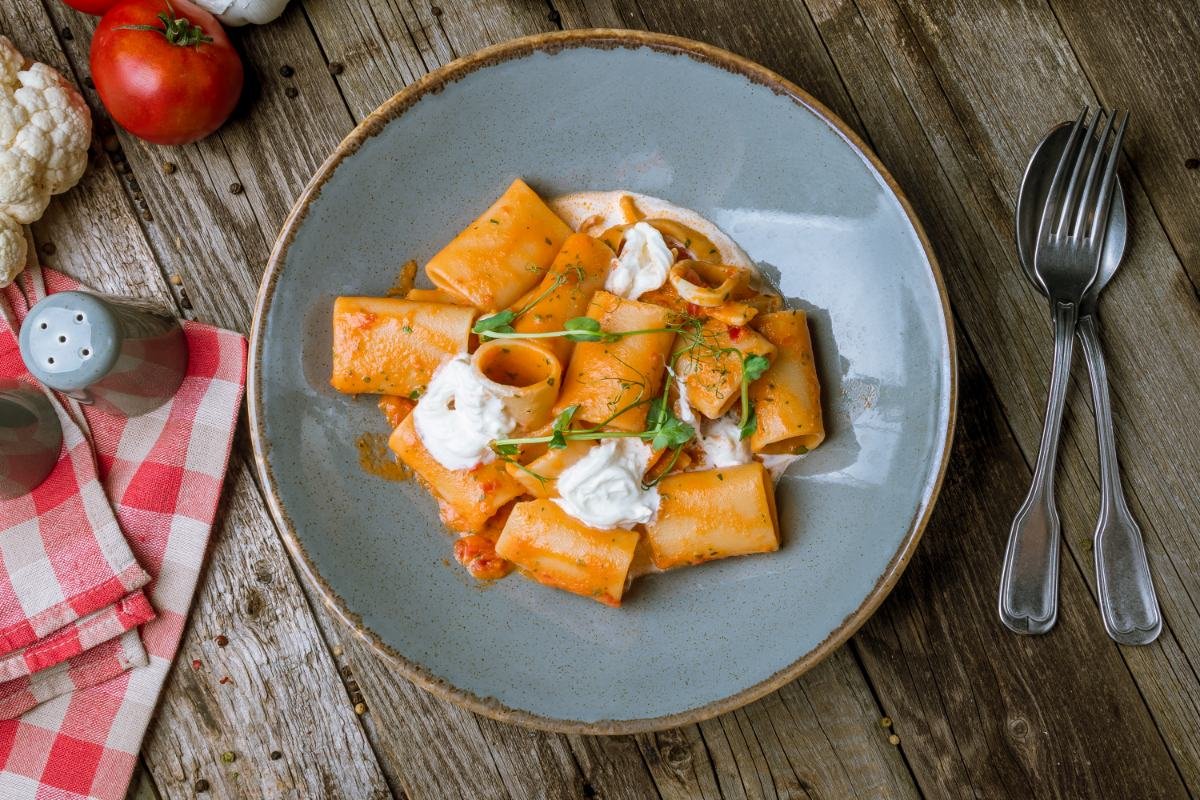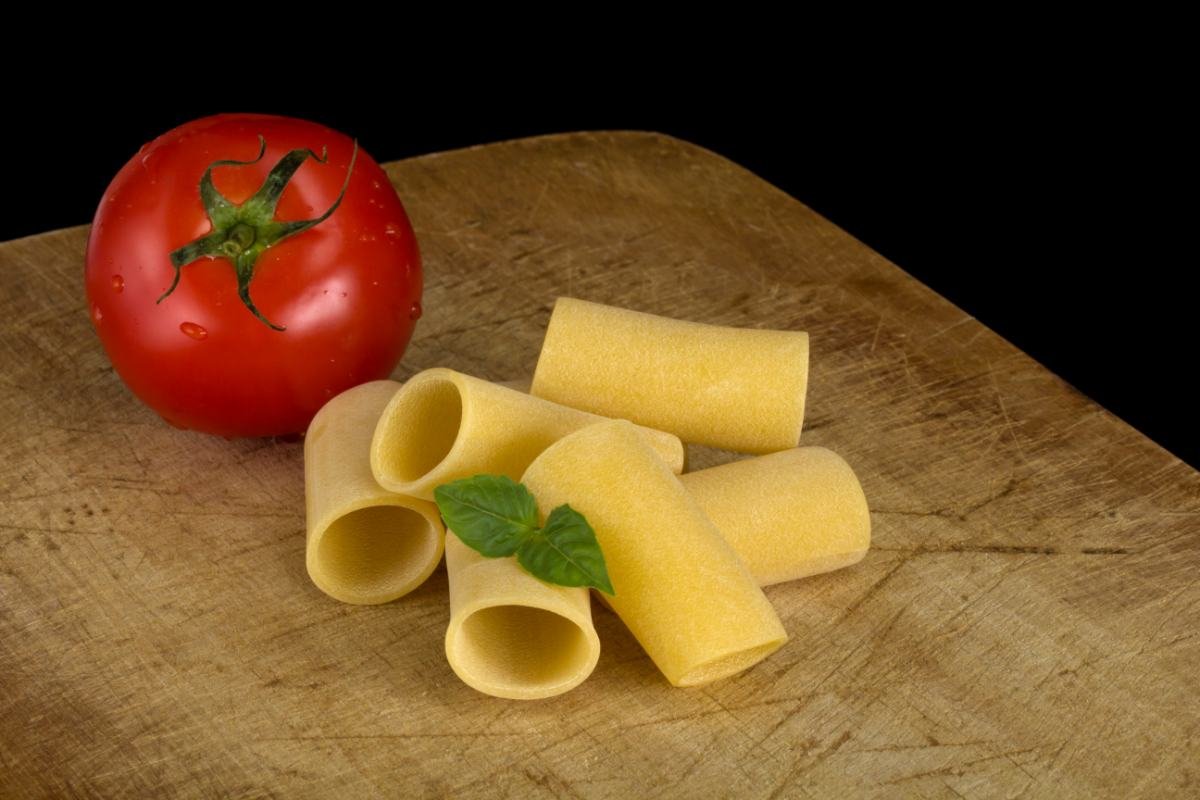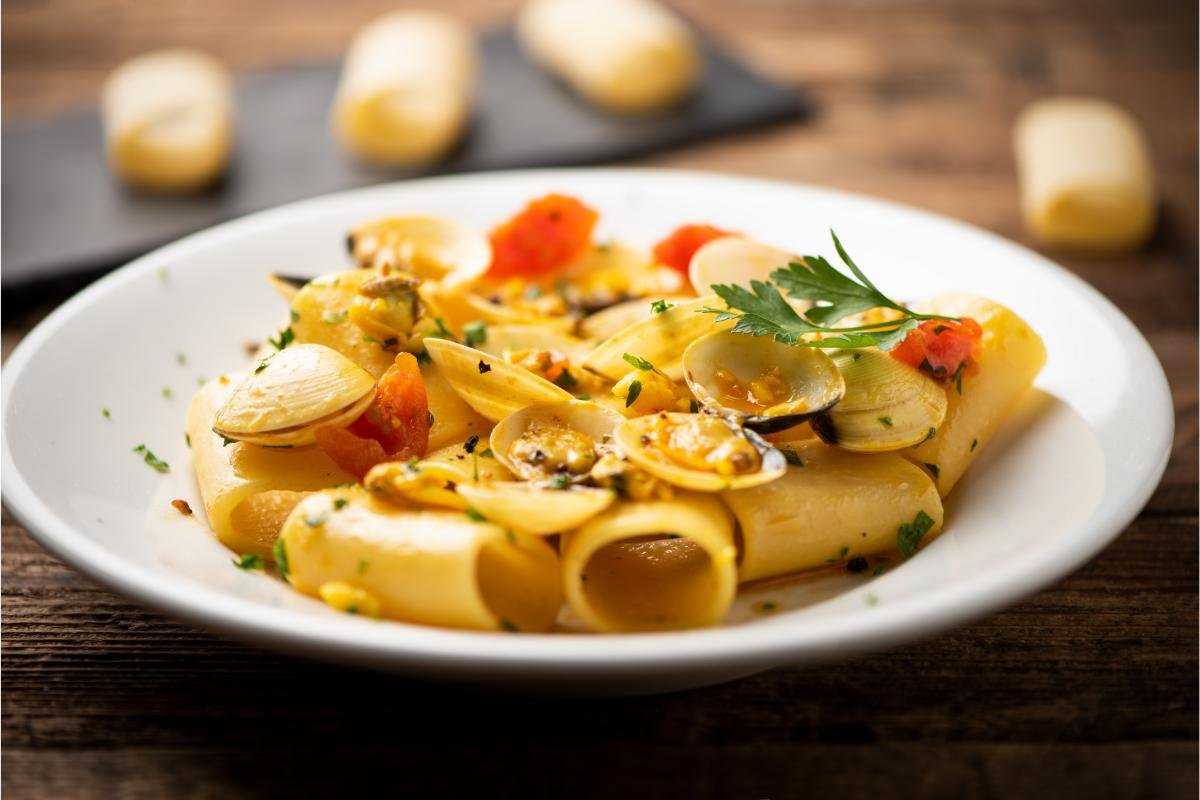Paccheri, a type of pasta that originates from Italy’s Campania region, stands out for its large, hollow tubes, resembling giant rigatoni. The name “paccheri” interestingly comes from the Neapolitan word for “slaps,” hinting at the sound they make when mixed with sauce. Ideal for beginners, paccheri is versatile and easy to cook, making it perfect for a variety of dishes, from simple tomato sauces to rich, hearty fillings. This blog aims to demystify paccheri, guiding beginners through its history, how to cook it, and offering delicious, easy-to-follow recipes. Join us as we explore the delightful world of paccheri, a pasta that brings the essence of Italian cuisine to your kitchen with minimal effort and maximum flavor.
The Cultural Significance of Paccheri

Paccheri pasta carries with it not just the flavors of Italian cuisine but also a rich history and cultural significance that resonates across the regions of Italy. This section delves into the origins of paccheri, its regional variations, and the integral role it plays in Italian culinary traditions, highlighting the depth of this seemingly simple pasta.
A Journey Through Time: The Origins of Paccheri
The story of paccheri begins in the vibrant landscapes of Italy, more specifically in the Campania region, known for its rich culinary heritage. Historians suggest that paccheri emerged as a response to import bans, ingeniously designed to smuggle banned goods like garlic cloves across borders in their hollow centers. Whether this tale holds true or not, it adds a layer of intrigue to paccheri’s history, illustrating the creativity and resourcefulness of Italian pasta makers.
Regional Pride: Variations Across Italy
Paccheri proudly stands as a symbol of regional diversity within Italian cuisine. While it hails from Campania, chefs and home cooks across Italy have embraced paccheri, each region tailoring it with local flavors and ingredients. In Naples, for example, paccheri serves as the foundation for classic dishes like ‘Paccheri alla Napoletana,’ featuring robust tomato sauces and seafood. Meanwhile, in Sicily, it might be adorned with rich, aromatic pesto and fresh seafood, showcasing the island’s bounty. These regional variations not only highlight paccheri’s versatility but also celebrate the local produce and culinary traditions that define Italy’s gastronomic landscape.
A Staple of Italian Tradition
Beyond its versatility and historical roots, paccheri holds a special place in the heart of Italian culinary tradition. It symbolizes the importance of gathering around the table, of meals that bring families together. In many Italian households, cooking paccheri is a labor of love, a way to honor traditions passed down through generations. The process of selecting the perfect sauce, pairing it with paccheri, and sharing the meal with loved ones embodies the Italian ethos of food as a communal, celebratory experience.
Italian festivals and special occasions often feature paccheri, further cementing its role in cultural expressions. From simple family gatherings to elaborate feasts, paccheri dishes are a testament to the pasta’s enduring appeal and its ability to bring people together in joyous celebration.
Types of Paccheri
Exploring the different types of paccheri is akin to delving into a chapter of culinary versatility. This section will guide you through the variations of paccheri pasta, offering insights on how to choose the right type for your dish and providing beginner-friendly tips for identifying quality paccheri. Each variation brings its own unique qualities to the table, enriching dishes with distinctive textures and flavors.
Paccheri Lisci: The Smooth Classic
Paccheri Lisci, characterized by its smooth surface, is the classic form of this beloved pasta. This variety’s sleek texture allows sauces to cling to the pasta, ensuring each bite is as flavorful as the last. Ideal for thick, hearty sauces or a simple, elegant tomato basil, Paccheri Lisci serves as a versatile canvas for a multitude of recipes. When selecting Paccheri Lisci, look for pasta with a consistent, smooth texture and a rich, creamy color, indicators of quality and authenticity.
Paccheri Rigati: The Textured Twist
For those seeking a bit more grip in their pasta, Paccheri Rigati offers a textured surface that’s perfect for catching and holding onto every type of sauce. The ridges in Paccheri Rigati enhance the pasta’s ability to bond with sauces, from the light and creamy to the robust and chunky, making every mouthful a symphony of flavors. When shopping for Paccheri Rigati, ensure the ridges are well-defined and the pasta has a firm, resilient feel, signs of a well-made product.
Choosing the Right Type for Your Dish
The key to selecting the right type of paccheri lies in the sauce and preparation method. For lighter, more delicate sauces or when serving the pasta in a broth, opt for Paccheri Lisci to allow the subtlety of the sauce to shine through. On the other hand, Paccheri Rigati is your ally for thicker, more textured sauces, where its ridges can trap and hold onto the sauce, ensuring a flavorful experience with each bite.
Tips for Identifying Quality Paccheri
Quality paccheri should have a uniform color and texture, free from cracks or discoloration. The best paccheri has a rough, porous surface, a characteristic that indicates it will hold sauce well. Additionally, quality paccheri pasta is typically made from durum wheat semolina, offering a perfect blend of firmness and elasticity when cooked. Always check the packaging for indications of traditional manufacturing processes, such as “bronze cut,” which refers to a method that gives the pasta its ideal texture for sauce adhesion.
Basic Ingredients and Tools Needed for Cooking Paccheri

Mastering the art of cooking paccheri begins with a simple set of high-quality ingredients and a few essential kitchen tools. This section outlines the fundamentals you’ll need to start your paccheri culinary adventure. Embracing simplicity and focusing on the quality of each component will set the stage for delicious, authentic Italian dishes.
Essential Ingredients for a Simple Paccheri Dish
- Paccheri Pasta: The star of your dish. Opt for high-quality paccheri made from durum wheat semolina to ensure a perfect texture after cooking.
- High-Quality Olive Oil: A staple in Italian cooking, select extra virgin olive oil for its rich flavor and aroma.
- Fresh Garlic: The foundation of many Italian sauces, fresh garlic adds depth and character to your dish.
- Ripe Tomatoes: Whether using fresh tomatoes for a vibrant sauce or high-quality canned tomatoes, they’re essential for creating the classic paccheri tomato sauce.
- Fresh Basil: A few leaves can transform a simple sauce with their fresh, aromatic touch.
- Salt and Pepper: Essential seasonings to enhance the natural flavors of your ingredients.
- Parmesan Cheese: For serving, freshly grated Parmesan cheese adds a salty, umami-rich finish to your pasta.
Kitchen Tools and Equipment for Cooking Pasta
- Large Pot: For boiling the paccheri, ensuring there’s enough water to cook the pasta evenly without sticking.
- Colander: Essential for draining the pasta once it’s cooked to the perfect al dente texture.
- Saucepan or Skillet: For preparing your sauce. Choose one with enough depth to mix the pasta and sauce together if you prefer to serve your paccheri in the Italian tradition.
- Wooden Spoon: Ideal for stirring pasta and sauces gently to prevent sticking or breaking the pasta.
- Cheese Grater: A must-have for adding fresh Parmesan cheese to your finished dish.
- Knife and Cutting Board: For chopping fresh ingredients like garlic, tomatoes, and basil.
Beginner Tips for Ingredient Selection and Kitchen Setup
- Focus on Freshness: The simplicity of Italian cooking means the quality of your ingredients matters. Choose the freshest produce and high-quality pantry staples you can find.
- Readiness is Key: Before you start cooking, have all your ingredients prepped and tools within reach. This mise en place approach ensures a smooth cooking process.
- Pasta Water is Gold: Save a cup of pasta water before draining your paccheri. Its starchiness is perfect for adjusting the consistency of your sauce if needed.
- Experiment with Confidence: Don’t be afraid to adjust quantities or substitute ingredients based on availability or taste preferences. Cooking is an art, not a science.
- Clean as You Go: Keep your workspace tidy to enjoy the cooking process more and make cleanup easier.
Step-by-Step Guide to Cooking Paccheri

Mastering the art of cooking paccheri is a journey that begins with understanding the basics. This comprehensive guide takes you through every step of the process, from boiling the pasta to perfection to marrying it with a sumptuous sauce. Let’s dive into the art of crafting a delightful paccheri dish that would make any Italian nonna proud.
Preparing the Pasta: Boiling and Draining Techniques
- Boil Water with Salt: Start by filling a large pot with water, bringing it to a rolling boil. Generously salt the water — it should taste as salty as the sea. This is crucial for flavoring the pasta from the inside as it cooks.
- Cooking the Paccheri: Add the paccheri to the boiling water, stirring occasionally to prevent sticking. Check the pasta a couple of minutes before the package’s suggested cooking time for an al dente texture — tender with a slight bite.
- Draining the Pasta: Once the paccheri reaches al dente perfection, reserve a cup of pasta water for adjusting the sauce’s consistency later. Then, drain the pasta in a colander. Avoid rinsing to ensure the sauce clings to the pasta’s surface.
Choosing and Preparing a Sauce
- Select Your Sauce: Whether a classic tomato basil, a hearty meat ragù, or a creamy Alfredo, choose a sauce that complements the robust shape of paccheri. The large tubes are perfect for thick, chunky sauces that get trapped inside, delivering flavor in every bite.
- Sauté the Base Ingredients: Begin your sauce by sautéing base ingredients like garlic or onions in olive oil until fragrant. This builds a foundation of flavor for your sauce.
- Add Main Ingredients: Incorporate your main sauce ingredients, such as crushed tomatoes for a tomato sauce or cream and cheese for an Alfredo. Simmer until the sauce thickens slightly, allowing the flavors to meld together.
- Season to Taste: Don’t forget to season your sauce with salt, pepper, and any other desired herbs or spices. Fresh herbs like basil should be added towards the end to preserve their flavor and color.
Combining the Pasta and Sauce: Tips for a Perfect Dish
- Mixing Pasta and Sauce: Instead of merely topping the pasta with sauce, mix them together in the skillet or saucepan. This allows the paccheri to absorb the sauce, enhancing the flavors. Use a bit of the reserved pasta water to adjust the sauce’s consistency if necessary.
- Let It Rest: After combining, let the pasta and sauce rest together for a minute or two before serving. This resting period allows the pasta to soak up the sauce, ensuring every tube of paccheri is perfectly coated and flavorful.
- Serving: Serve the paccheri hot, garnished with fresh herbs, grated Parmesan, or a drizzle of quality olive oil to elevate the dish further.
Tips for a Flavorful Experience
- Pasta Cooking Water: Don’t underestimate the power of pasta cooking water. Its starchiness helps thicken the sauce and improve its adherence to the pasta.
- Quality Ingredients: The simplicity of Italian cooking means that the quality of each ingredient shines through. Opt for the best quality pasta, olive oil, and fresh produce you can find.
- Experiment with Fillings: Given paccheri’s large size, consider stuffing them with ricotta and spinach or ground meat and herbs for a different take on the classic pasta dish.
Creative Recipes for Beginners
Diving into the world of paccheri, beginners can explore a variety of flavors and techniques that highlight the pasta’s versatility. This section presents three beginner-friendly recipes, each showcasing a different aspect of paccheri’s charm. From the simplicity of a classic tomato sauce to the hearty embrace of baked dishes and the elegance of seafood, these recipes are designed to inspire and delight.
Paccheri with Tomato and Basil Sauce
A timeless classic, this dish celebrates the fresh flavors of Italy with minimal ingredients and straightforward preparation.
Ingredients:
- 400g paccheri pasta
- 2 tablespoons extra virgin olive oil
- 3 cloves garlic, minced
- 400g canned crushed tomatoes
- A handful of fresh basil leaves, torn
- Salt and freshly ground black pepper, to taste
- Grated Parmesan cheese, for serving
Instructions:
- Cook the Paccheri: Bring a large pot of salted water to a boil. Add paccheri and cook until al dente. Drain, reserving a cup of pasta water.
- Prepare the Sauce: Heat olive oil in a skillet over medium heat. Sauté garlic until fragrant. Add crushed tomatoes, season with salt and pepper, and simmer for 10-15 minutes.
- Combine and Serve: Toss the cooked paccheri with the tomato sauce, adding a splash of pasta water if needed to adjust consistency. Stir in fresh basil just before serving. Plate the pasta and sprinkle with grated Parmesan cheese.
Paccheri al Forno with Mozzarella and Eggplant
This baked paccheri dish is a comforting meal, perfect for gatherings or a cozy night in.
Ingredients:
- 400g paccheri pasta
- 1 large eggplant, cut into cubes
- 250g mozzarella cheese, diced
- 400g canned crushed tomatoes
- 2 cloves garlic, minced
- Olive oil, for cooking
- Salt and pepper, to taste
- Fresh basil leaves, for garnish
- Grated Parmesan cheese, for topping
Instructions:
- Preheat Oven and Prepare Ingredients: Preheat your oven to 180°C (350°F). Lightly salt the eggplant cubes and let them sit for 15 minutes to draw out moisture. Rinse and pat dry.
- Cook Paccheri and Eggplant: Boil paccheri until just shy of al dente. In a skillet, heat olive oil over medium heat and sauté eggplant until golden.
- Assemble the Dish: In a baking dish, layer half the paccheri, followed by half the sautéed eggplant, mozzarella, and crushed tomatoes. Repeat the layers, finishing with a layer of tomatoes. Sprinkle with Parmesan cheese.
- Bake: Cover with foil and bake for 20 minutes. Remove foil and bake for another 10 minutes until cheese is bubbly and golden. Garnish with fresh basil before serving.
Seafood Paccheri
Embrace the flavors of the sea with this elegant yet easy seafood paccheri recipe.
Ingredients:
- 400g paccheri pasta
- 2 tablespoons olive oil
- 2 garlic cloves, minced
- 200g mixed seafood (e.g., shrimp, scallops, squid rings)
- 200g canned cherry tomatoes
- A splash of white wine
- Fresh parsley, chopped
- Salt and pepper, to taste
Instructions:
- Prepare the Pasta: Cook paccheri in a pot of boiling salted water until al dente. Drain, reserving some pasta water.
- Cook the Seafood: In a large skillet, heat olive oil over medium heat. Add garlic and sauté until golden. Add the seafood, cooking until just opaque. Deglaze the pan with white wine.
- Finish the Sauce: Add cherry tomatoes to the skillet, season with salt and pepper, and simmer until the sauce thickens slightly.
- Combine and Serve: Toss the cooked paccheri with the seafood sauce, adding pasta water as needed to achieve the desired consistency. Garnish with fresh parsley before serving.
Perfecting Your Paccheri: Tips for Every Cook
Achieving culinary success with this Italian staple involves a few essential strategies. From cooking to perfection to choosing the right sauces and presentation tips, this guidance ensures your dishes impress every time.
Ideal Texture and Timing
- Monitor Cooking Closely: Begin testing the pasta slightly before the suggested time on the package to capture that ideal ‘al dente’ quality.
- Generous Water Usage: A large pot of boiling water ensures even cooking and prevents the pieces from sticking.
- Salt for Flavor: Adequately salt the water for seasoning that penetrates the pasta.
Selecting Sauces
- Harmony with Sauce: The thickness and ridges of this pasta make it suitable for hearty sauces. Match the sauce consistency to the pasta’s character for a balanced dish.
- Flavor Combinations: Adapt the sauce based on the dish’s main ingredients, experimenting with different herbs and spices for unique tastes.
Storage and Presentation
- Properly Store Leftovers: Keep any extra pasta in an airtight container in the fridge, maintaining its quality for up to five days.
- Reheat with Care: To maintain moisture when reheating, add a bit of water or sauce. This method helps preserve the pasta’s texture and flavor.
- Garnishing and Plating: Enhance the dish’s appearance and taste with fresh herbs or a sprinkle of cheese. Presenting your pasta thoughtfully can transform the dining experience.
Conclusion
Our exploration of paccheri has shown us the vast possibilities this pasta presents, from its rich cultural background to its culinary versatility. We’ve shared the essentials for selecting, cooking, and enjoying paccheri, alongside tips and recipes to enhance your cooking experience. Remember, the essence of Italian cooking lies in simplicity, quality ingredients, and the joy of sharing meals.
For more culinary adventures and recipes, be sure to visit recipeszap.com, where the journey into delicious Italian cooking continues. May your kitchen always be a place of exploration, joy, and shared moments over great food. Buon appetito!

